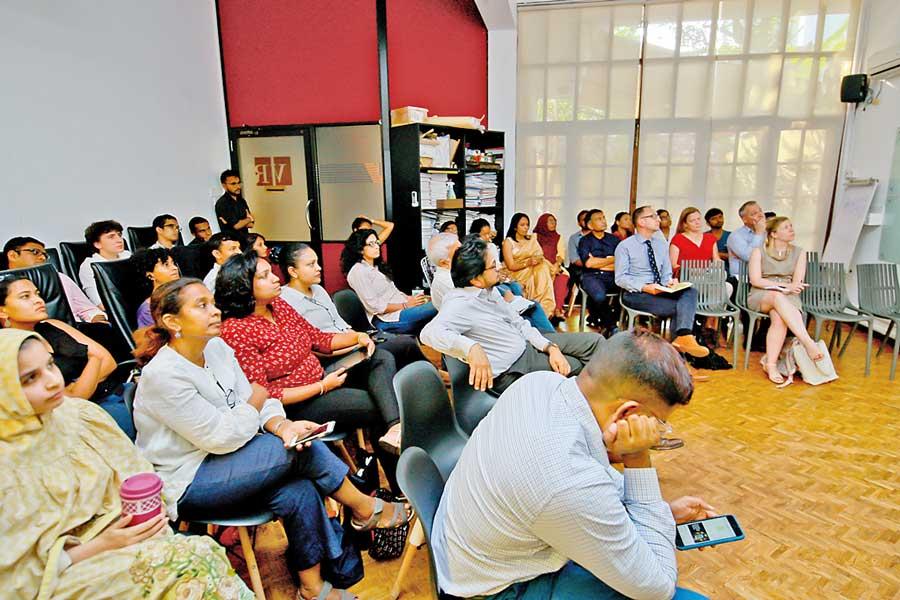Reply To:
Name - Reply Comment

Section of participants
Pix by Damith Wickramasinghe
By Kamanthi Wickramasinghe
A systematic review of Sri Lanka’s post-war defence budget reveals that Sri Lanka spends too much on defence and the defence budget is spent inefficiently.
The study done by Daniel Alphonsus, who had served as an advisor to Sri Lanka’s finance minister with experience working at the Foreign Ministry and Verité Research, aimed to point out the loopholes in the existing defence economics structure and how it could be improved.
From a public finance perspective, defence is 12 percent of the Government of Sri Lanka (GOSL) spending while the armed forces, civil security and police are 40 percent of the GOSL
wage bill.

“If you check the security perspective, Sri Lanka has a poor record of maintaining its monopoly of violence,” he said while explaining his research to a selected audience.
“We have had riots to assassinations, insurgencies, civil wars, foreign interventions and Easter Sunday bombings. It reflects poorly on the state’s ability to maintain security. The prima facie reason to think that the defence budget is spent inefficiently is that following the end of war, there seems to be a paradigm shift in the strategic environment. The LTTE was defeated and even though there have been no conventional threats to Sri Lanka, there had been a continuity in the defence budget.
In Sri Lanka, we don’t have a defence review or a national security strategy that outlines the threats and what our national security objectives should be. On the other hand, the Defence Ministry, Treasury and Parliament don’t have specialists on security or defence economics to interrogate and have a dialogue about what an optimum budget should
look like.
I also see a failure in public reasoning capacity, where the media and universities are think tanks that haven’t approached this question in a systematic way, during the last couple of decades.”
Allocative question
According to the research, an average defence budget of US $ 421 million allocated during 1983-1987 has risen to US $ 1499 million during 2006-2009. The post-war average budget is estimated to be US $ 1716 million.
“This shows defence spending is higher than it was at the peak of the war. Averages keep increasing and continue thereafter. The new normal is three times higher than the previous peacetime. According to the World Bank data, Sri Lanka’s defence budget is 11 percent of the Central Government expenditure while it lies at only 5.79 percent in countries with a similar population.”
He further showed data, which proves how Sri Lanka is spending roughly the same amount of money as Myanmar, which has a population of 50 million and the Philippines, which has a population of roughly 100 million. If it was spending similarly to New Zealand, it should considerably increase its military capability as well.
According to Jane’s Defence Review, Sri Lanka relatively has high capability in artillery, armour and infantry in the land domain and logistics in the maritime domain. However, this reflects wartime security needs rather than post-war security needs. However, there had been a broad continuity in the defence budget.
More investment on manpower
According to Alphonsus, what’s driving this is spending too much on manpower.
“If you look at the world average, only 40 percent of the defence budget is spent on manpower but in Sri Lanka, it’s 70 percent. There are two reasons for this – either we are paying the military a lot or we have too many men. My argument is the latter. These statistics don’t include the Civil Defence Force and certain other regiments either. We could also see how 0.5 percent of Sri Lanka’s population is in the armed forces while over 2.50 percent of the labour force is in the armed forces. In Europe it’s below one percent.
One reason for this could be demobilisation. If you take the US situation, the number of people in the armed forces changes with the strategic environment. What’s also driving this high personal cost and the number of men is that we don’t have reserves.
In every other region of the world, reserves play an important role in meeting the country’s security requirement. If you look at allocations within services, there’s a higher spending on the Army than Navy and Air Force. If you take the defence budget in the context of the security budget, 75 percent of the defence is the sum of these three, while law and order is about 20 percent and diplomacy is about 5 percent.”
Speaking on the spillover effect he stressed that if less money is spent on the defence budget, more money could be allocated to pay off debts, thereby having more macroeconomic stability.
“In terms of labour markets, when you’re releasing a 100,000 of your able-bodied into the labour market, that’s going to affect your wages. If we take the industrial policy you can spend on training people, manning people on electronics and feed them to labour markets as well.”
He concluded by saying that the future looks worrying as the military’s share of pensions have risen from 16.5 percent to 17 percent. The paper recommends that people with civilian military expertise with a background in defence economics should be appointed to set about a defence budget. Apart from that, a capability-based security budget needs to be published and the expenditure needs to shift to police, intelligence and diplomacy as well.